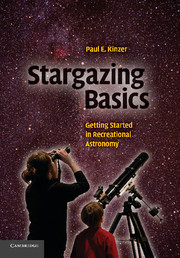Part II - What's up there?
Published online by Cambridge University Press: 12 August 2009
Summary
To infinity … or close enough!
Once you have the equipment needed – or better yet, before you do – you will want to get right out there to start exploring the night sky. Part II attempts to answer the question its title asks in as basic a way as possible. It will not give you all the information you need to find the objects in the sky; for that you will need a field guide, or star charts. It is merely meant to be a very brief tour, to give the novice some understanding of what the various objects are, as well as an idea of what they might look like through a beginner scope. The trip will start nearby, and move outward.
However, before getting to specific object descriptions, I should start with a warning: you will only be disappointed if, when looking through your telescope, you expect to see things as they appear in books or magazines, or on television or the internet. The brightness and, especially, the color in those images cannot be seen through the eyepiece of an amateur scope. Such things are only possible to record through time-exposure astrophotos, and such photos are often taken through giant telescopes at professional observatories, or even by artificial satellites and other spacecraft. Amateurs have taken and do take great astrophotos, and even a beginner's equipment is enough for shooting some targets. All the photos in this book were taken, by me, with modest amateur equipment.
- Type
- Chapter
- Information
- Stargazing BasicsGetting Started in Recreational Astronomy, pp. 71 - 72Publisher: Cambridge University PressPrint publication year: 2008



